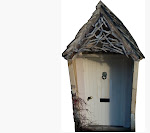 The Old Woman in the Woods by Adam Oehlers
The Old Woman in the Woods by Adam Oehlers
I have several collections of the Grimms' tales, but I've had my favourite since I was seven. It's a big chunky book called
The Illustrated Treasury of the Brothers Grimm, illustrated by Luděk Maňásek, with translations by Vladimir Varecha.
The illustrations are peculiar but vivid, the translations are written in a bright, simple style and the publisher is (rather fittingly) called Treasure Press. But, for me, the best thing about this book is how many tales it has in it: 87. Which is still only a portion of the 210 tales included in the Grimms' final (1857) edition of
Children's and Household Tales, but it's more than are in the other collections I own. It's a book I can still get lost in.
I often wonder what makes editors choose a small number of the Grimms' tales to publish over and over again, particularly when it comes to illustrated texts and picture books. Perhaps it's because they think readers only want to revisit tales they are familiar with, but there are many other wonderful tales hidden away that I'm sure would become just as popular if they were given the chance.
I think my favourite is
The Old Woman in the Wood. It's a strange name for a story in which the said old woman plays only a small (but villainous) part. The tale is really about a girl who finds herself lost in a forest. She is visited by a bird who brings her keys so she can unlock the trees... (I'm not going to say any more because I want to encourage you to follow the link and read it in full).
Some other tales I've long loved but haven't found elsewhere as often as I would have liked are:
The Glass Coffin—which features a tiny castle and a princess trapped in glass chests (although AS Byatt has retold this and you can find her fantastic version in both
Possession and in
The Djinn in the Nightingale's Eye);
Jorinde and Joringel—which is a beautiful bird transformation tale; and
The Seven Ravens—another bird transformation tale, which features a sister setting out to rescue her brothers from inside a glass mountain.
I have been reading from
The Illustrated Treasury of the Brothers Grimm since I was seven and I can't see myself ever tiring of it. In
Once Upon a Time: On the Nature of Fairy Tales, Max Lüthi has this to say about the appeal of fairy tales for adults, as well as children:
The fairy tale portrays, in a wider sense than is generally realized, a harmonious world. The confidence from which it flows is transmitted to both those who tell it and those who hear it. Thus, it is no wonder that not only children come under its spell, but that it repeatedly exerts its charm over adults. It gives not only pleasure, it gives form and inspiration; and we can readily believe the report of a north German storyteller that a soothing and healing power can emanate from fairy tales when told to sick people in hospitals. Every fairy tale is, in its own way, something of a dragon slayer.
The beautiful illustration at the head of this post is by
Adam Oehlers, whose story 'Dear Little Emmie' features in the
latest issue of
New Fairy Tales. Adam is extending the story at the moment and it will be published as a book in early 2011.
The tales I have linked to above are from Margaret Hunt's 1884 translation. All 210 tales from this translation are available on the
SurLaLune site.










